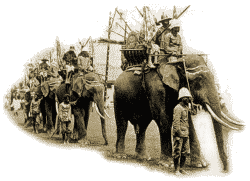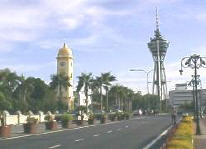|
|
abcmalaysia.com
|
|
|
Malaysia Travel Guide |
| About Malaysia Johor Kedah Kelantan Kuala Lumpur Labuan Melaka N. Sembilan Pahang Penang Perak Perlis Putrajaya Sabah Sarawak Selangor Terengganu |
|
|||||||||||||||||
|
• History • People & Culture • Economy • Alor Setar • • Shop & Dine • Getting There • Travel Tips • Weather •
History Kedah has a long history; the Bujang Valley has remains of a Hindu-Buddhist kingdom that dates back to the 4th century AD, making it the oldest civilization of Peninsular Malaysia. Before the sea route around the peninsula was firmly established, trade between India and China was conducted across the peninsular isthmus. The current royal family can trace its line directly back to this time. the Thai states to the north. Kedah's ancient civilization waned in importance by the 15th century, when Malacca assumed a more dominant role. The establishment of Islam in Kedah is due to Malacca's influence. When Malacca fell to the Portuguese, the influence of its Sultanate over Kedah weakened.
Nonetheless, Kedah fell to the Thais in 1821. Thailand transferred their sovereignty to the British in 1909. With the exception of the period of occupation by the Japanese during World War II, Kedah remained under British influence until independence. The Kedah Sultanate began when the 9th Kedah Maharaja Derbar Raja (1136-1179 AD) converted to Islam and changed his name to Sultan Muzaffar Shah. Since then there have been 27 Sultans who ruled Kedah
People & Culture songs and dances. Due to its close proximity to Thailand, some of these traditions are Thai in influence and origin, and faces of Kehah's people often bear signs of Thai or Achinese ancestry. The people of Kedah are generally padi planters with most living in kampungs next to their fields. 19% Chinese, 8% Indian and 1% Others.
Economy Together with Perlis, Perak, and Kelantan, this northwest state shares a common border with Thailand in the north. Known as the "Rice Bowl of Malaysia", the Kedah-Perlis rice plains produce more than half of the country's home grown rice supply. Other agricultural products, including rubber, oil palm and tobacco are also important. Although predominantly an agriculture-based State, the State is, shifting its economic thrust from agriculture to industry. Industrial estates have sprung up in Alor Setar, Kuala Kedah, and Sungai Petani while the government has started developing and promoting tourist facilities.
Alor Setar
Shop & Dine Like Malaysia's other states, there are shops and modern malls in most major towns, as also are the presence of western fast food outlets such as Mc Donald's and KFC.
LOCAL CUISINE The state offers mouth-watering recipes of Kedah cuisine, which is not only unique but also prepared fast enough to whet the appetite of everybody. It has a wide variety of Thai, Chinese, Malay, and Indian food to choose from. Traditional local dishes, which are favorites, are ‘gulai nangka’, ‘sayur keladi’, and ‘pekasam’. ‘Nasi ulam’ is another local food which is prepared by blending rice with varied fresh vege's and spices. ‘Pulut’, or glutinous rice is an old-time favorite of the northerners and is taken with fruit such as mango, durian and even banana. Other pulut delicacies are ‘pulut sambal’, ‘pulut inti’, and ‘tapai pulut’. ‘Laksa’ is rice noodles taken with a preparation of thick fish gravy and cucumber, onion and shoots. Popular sweet cakes are ‘baulu’ and the ‘dodol’ – a preparation of coconut, sugar, and flour.
The food stalls at Pantai Murni Esplanade is a great place to relish the wide-range of local foods. Take your pick from an array of spicy Malaysian and Kedah favorites. Your best choice would be the varied preparations of fresh seafoods such as chilli crabs, grilled squids, fish or prawns. The breezy esplanade draws the crowd to its excellent panorama of beautiful sunset amidst the speckle of islands beyond If you love sea products, you may go to Tanjung Dawai, it's a fishing village. You can find salted fish, fish crackers, salted sea food etc. sold in the Bazaar. The Bazaar is very small. From Tanjung Dawai you can see Pantai Merdeka.
HANDICRAFTS & SHOPPING The famous ‘Pekan Rabu’ (Wednesday Market), consisting of many small stalls offers a variety of products, ranging from farm produce to handicrafts. Local delicacies and Kedah food is also available here. Opens from morning to midnight.
Consider picking up something from Langkawi Crystal. Gorgeous crystal pieces, both decorative and functional, skillfully crafted and blown. Also look out for the famous Langkawi Marble, with marble from the legendary Pulau Dayang Bunting.
Getting There Being a border state with Thailand, Kedah has a border entry point at Bukit Kayu Hitam.
By Road The north-south expressway has made it easy for any traveler to drive up to Kedah. Roads are accessible from major towns and cities in the Peninsula. It is a 7-8 hour drive from Kuala Lumpur. From major towns, such as Kuala Lumpur and Penang, air-conditioned express buses are also available. They service almost all towns in Kedah. The Malaysian railway (KTM) services major towns in Kedah. The airport is located approximately 11km north of Alor Setar. Malaysia Airlines and Air Asia flies daily to and from Alor Setar from Kuala Lumpur via either Penang or Kota Bharu.
Travel Tips Weekends & Holidays It has different business hours than most of the other states. Banks and government offices are closed on Friday. Saturday is a half-day and Sunday is a working day. are peak seasons and resort bookings such as in Langkawi may not be available, unless it is made early.
Cash & Credit Cards and establishments. Similarly, ATM machines are also widely available especially at the bigger towns. Cash would always be the better option. Money changers are easily available at the popular resort island of Langkawi and generally so at most major towns in the state.
Weather
|
|
||||||||||||||||


